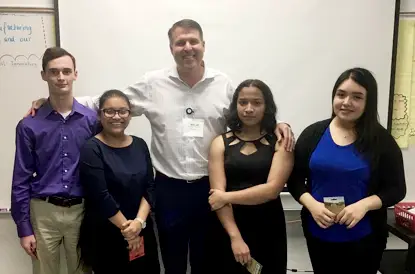
The RTI Center for Education Services (CES) partnered with Wilson Academy of Applied Technology (WAAT) during its inaugural year (2016–2017) to provide instructional support for STEM-focused project-based learning (PBL) aligned with the school’s focus on advanced manufacturing. CES continues to provide instructional, leadership and peer networking support with similarly situated innovative high schools.
RTI’s support contributed to the following outcomes in student achievement growth at WAAT, based on 2018 results:
- School achievement score: 17.1 percentage point growth, from 62.0 to 79.1
- Overall school performance score: 13 percentage point growth, from 66 to 79
- Dual-credit opportunities for students have expanded from one postsecondary credential to more than five in two years.
In this post, originally published on PBLWorks, WAAT Principal Krystal Lane Cox details the impact of RTI’s project-based learning support on her students.
When Wilson Academy of Applied Technology opened in 2016, I knew as the principal and instructional leader that Project Based Learning (PBL) was needed in our school.
The origin of our school was to be an early college high school that would revive and innovate the traditional trade school. We were created to spark interest in technical jobs that were being left open in our community.
Knowing our school’s focus, I believed PBL’s real-world, inquiry-based process would allow my students to solve problems related to the life we are constantly trying to prepare them for in the future. While I was sold, it was an uphill battle with my staff.
The battle wasn’t over their disbelief in the purpose of the instructional strategy, but how to effectively implement it and still teach the standards. So, each year, we have revamped, repositioned, and redefined our work. After much trial and error, we have concluded that our strongest projects are those that do not require manipulation of the standards. Before this conclusion, the frustration came when teachers tried to make the standards fit with the project.
Now, my number one expectation is that teachers plan for the standards first. If the project doesn’t speak authentically to the meaning, purpose, and teaching timeline for the standard, then that is not the project for the class. In North Carolina, every state course has standards specifications. So, the length and depth of the project should correspond with the percentage of focus and depth of the standard. This makes the experience authentic to the learning process that needs to occur.
Fast forward to 2019, when we feel that we are finally starting to optimize the potential of this process.
We were able to have our freshmen students solve a real-world problem from one of our local industry partners, Weener Plastics. This company makes caps and closures for many household products like Axe and Softsoap bodywash. For this project, our students would be solving a problem using the Lean Six Sigma DMAIC process. Weener Plastics had actually solved the problem earlier in the year, so we were able to get real data to help guide the conversations with our students.
The issue was with their French’s Ketchup bottle caps. The valves had the potential to pop out of the cap, which would be a costly and dangerous problem if this happened in the hands of the consumer. So, with the help of the company’s former president, Ryan Gladieux, students learned about this issue first-hand by watching a video of him setting up the problem. Over the course of a month, we planned a kick-off, a discovery day for the students to experiment with the bottles and valves, and workshop days for them to create their problem-solving pitch for Mr. Gladieux and other business leaders in our community.
The project connected to the content and standards from the students’ classes.
It was also a real problem that a company just a few miles from our school had to solve, so the students immediately bought into the project because the real-world application and relevance was present.
All freshmen students were taking Advanced Manufacturing 1. The foci of the course standards are quality and safety, which were the overarching problems the company was trying to solve for French’s. Students created charts about the torque and other measurements in their Math 1 class. Lastly, in English, they were able to sharpen their persuasive and argumentative skills through creating the final presentation and infographic that would be shared with the leaders of Weener Plastics.
So, what seemed like a daunting task three years prior was now coming together like a well-oiled machine. During the showcase our industry partners were wowed at how the students were able to articulate their potential solutions to the problem. While students could argue multiple solutions, one group actually solved the problem with the same solution as the engineering team at Weener Plastics.

The student team determined that too much torque was being used when tightening the caps at the end of the filling process with the ketchup. They also determined that the color of the caps played a factor in the amount of torque needed. The red, blue, and yellow caps were slightly smaller after the curing process, which made the torque needed different from the white caps. They came within a few decimal places of the appropriate amount of torque that should be used. The president of the company was impressed and stressed how he would love to hire students with their creativity after they have graduated from our school.
Hearing the president’s praise and seeing the students make connections between the real-world and the standards-based problem was confirmation that PBL was the perfect instructional strategy for our school.
It was a process that could clearly support the teaching and learning our state standards and provide students with authentic 21st century experiences.
Our school was created to help bridge the gap and become a pipeline between public education and the workforce. By opening our doors, our partners like Bridgestone Tires, Purdue Pharmaceuticals, Greenlight Community Broadband, Smithfield Foods, Stephenson Millwork, Construct Inc., 3C Store Fixtures, and Weener Plastics support the growth and development of our students. Now the staff and our community all believe projects like this have allowed and will continue to allow our students to be critical thinkers, globally prepared, and workforce-ready citizens.

